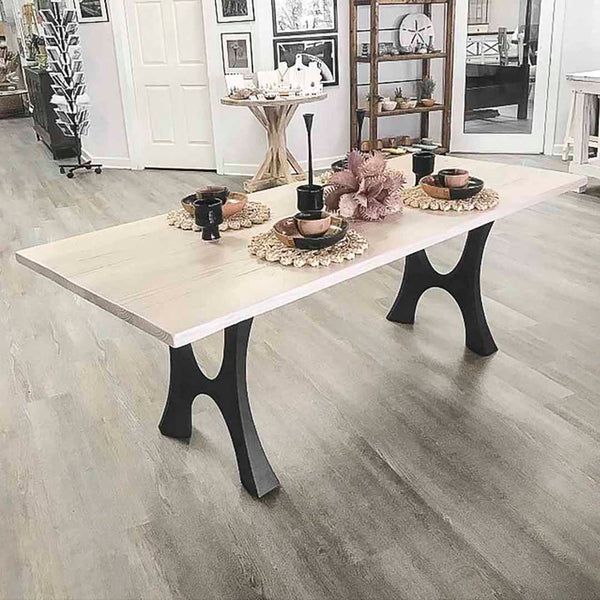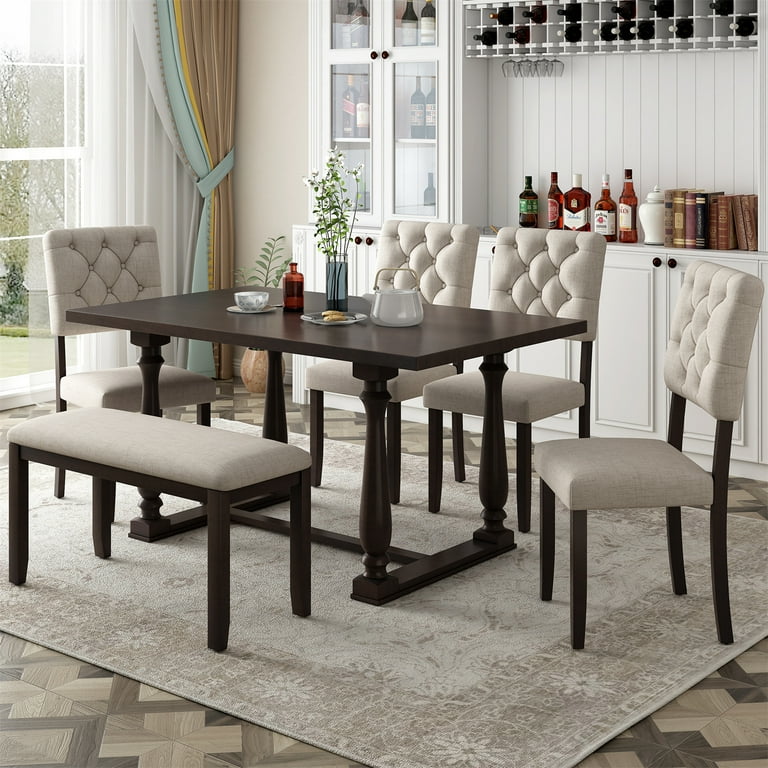Enhance Your Dining Room with Unique and Modern Dining Room Table Legs
Wiki Article
From Typical to Modern: Locate the Perfect Dining-room Table Legs for Your Style
The selection of dining-room table legs plays a crucial function in defining the general personality of your area, connecting the void in between conventional craftsmanship and contemporary aesthetic appeals. While timeless layouts such as cabriole and transformed legs evoke a feeling of timeless class, modern designs like barrette and geometric options offer a possibility for striking aesthetic rate of interest. Reviewing the appropriate equilibrium between these styles requires a nuanced understanding of your existing decor and personal preference. As you think about these components, the concern continues to be: exactly how can you seamlessly incorporate these diverse leg styles to create an unified dining experience?Comprehending Table Leg Styles
The selection of dining-room table leg styles can dramatically influence both the aesthetics and capability of the room. Each leg design adds unique sensible attributes and aesthetic aspects, satisfying varied layout preferences and usage demands. Recognizing these designs is vital for choosing the best eating table that aligns with your overall indoor style vision.For instance, tapered legs use a clean, traditional look that can improve a space's elegance, while stand bases provide stability and make best use of legroom, making them excellent for smaller areas. Hairpin legs, a hallmark of mid-century modern layout, introduce an industrial panache, permitting an airy, open feeling. In a similar way, trestle legs evoke rustic charm, supplying robust assistance and a feeling of timelessness.
In addition, the selection of products plays a substantial function. Wood legs can bring heat and structure, whereas steel choices frequently share a smooth, modern vibe. Ultimately, comprehending table leg styles is necessary for producing a natural dining location that reflects personal design while ensuring practicality and convenience. By attentively thinking about these components, you can improve both the useful and aesthetic charm of your eating space.
Typical Table Leg Options
When selecting dining space table legs, typical options frequently symbolize classic elegance and craftsmanship. These designs show a rich heritage and a dedication to top quality, making them ideal for those who appreciate traditional appearances.Among the most iconic traditional leg designs is the cabriole leg, identified by its graceful curved form. This style typically features ornamental makings and is most commonly found in Queen Anne and Chippendale furniture. One more popular choice is the turned leg, which boasts a series of smooth, rounded forms that provide a classic appearance while keeping security.
In addition, the straight leg, while straightforward, supplies a basic and strong structure that can blend seamlessly with a selection of tabletop designs. For those attracted to ornate outlining, claw-and-ball feet legs evoke a feeling of majesty and can function as a sensational centerpiece in any type of dining room.
Last but not least, stand bases, although not strictly legs, provide a different standard choice that allows for ample legroom and can be beautifully sculpted. Each of these standard leg styles contributes to the total atmosphere of a dining-room, marrying function with visual appeal.

Modern Table Leg Designs
Modern table leg layouts provide a diverse series of styles that stress clean lines and cutting-edge materials. These styles often focus on functionality while acting as striking centerpieces within an eating space. Minimal visual appeals are widespread, with legs crafted from materials such as steel, glass, and engineered wood, which add to a contemporary and ventilated feeling.One prominent layout is the hairpin leg, identified by its slender, conical framework that offers security without overwhelming the tabletop (dining room table legs). This design is frequently located in mid-century contemporary furnishings and can easily complement different table forms. An additional trend is the use of geometric forms, where legs might take on angular or asymmetrical kinds, adding visual passion and a touch of virtuosity

Blending Styles for Unique Spaces
Frequently, property owners seek to produce distinct dining spaces that reflect their individual design by mixing different layout elements. This strategy allows for the incorporation of diverse aesthetics, leading to an unified yet unique environment. For instance, matching a rustic wooden table with streamlined, modern-day steel legs can produce a captivating comparison that elevates the room's overall allure.Furthermore, incorporating vintage table legs with modern tabletops go to these guys can stimulate a sense of background while preserving a modern perceptiveness. Such combinations not just display individual preference but additionally motivate creativity, enabling property owners to curate a room that feels both individual and inviting.
Shade plays a vital role in this mixing process; picking table legs that complement or comparison with the existing color pattern can enhance visual passion. Whitewashed legs can soften the daring of a dark table surface, producing a well balanced aesthetic.
Tips for Picking the Right Legs
Selecting the right table legs is necessary for achieving both performance and visual appeal in your eating room. Begin by considering the general design of your room. Standard setups take advantage of legs that feature detailed carvings or turned styles, while modern spaces may require streamlined, minimalist designs.Next, examine the height and stability of the legs. dining room table legs. Typical eating tables range in between 28 to 30 inches in height, website here so guarantee the legs enhance this dimension for comfort. Additionally, robust products, such as wood or metal, can enhance stability and durability
Review the leg form too-- options include directly, tapered, or pedestal styles. Straight legs use a timeless appearance, while conical legs can include a touch of style. Pedestal bases supply adequate legroom and are excellent for smaller spaces.
Conclusion
In summary, selecting the ideal dining-room table legs requires careful factor to consider of both traditional and modern styles. Typical alternatives such as cabriole and transformed legs supply classic sophistication, while contemporary styles like hairpin and geometric shapes provide a modern touch. By integrating leg design, height, and material with the total decor, a natural and welcoming environment can be achieved. Ultimately, the picked table legs must show the desired aesthetic, boosting the eating experience within the space.The range of eating space table leg designs can dramatically affect both the appearances and functionality of the room. Eventually, understanding table leg designs is crucial for producing a cohesive eating location that shows individual style while ensuring functionality and comfort.One of the most famous traditional leg designs is the cabriole leg, characterized by its stylish curved shape. Straight legs supply a traditional appearance, while tapered legs can include why not try these out a touch of elegance.In summary, picking the optimal eating area table legs needs mindful consideration of both contemporary and typical styles.
Report this wiki page